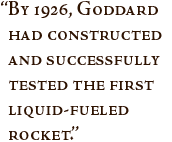

|
Goddard first obtained public notoriety in 1907 when he fired a powder rocket in the basement of the physics building at WPI. School officials then took an immediate interest in Goddard's work and, to their credit, did not expel him for the incident. In 1914, Goddard received two U.S. patents, one for a rocket that used liquid fuel, the other for a two- or three-stage rocket using solid fuel. At his own expense, he began to make systematic studies about propulsion provided by various types of gunpowder. This work resulted in his classic study in 1916 requesting funds from the Smithsonian Institution to continue his research. This was published along with his subsequent research in the Smithsonian Miscellaneous Publication No. 2540 (January 1920) entitled "A Method of Reaching Extreme Altitudes." In this treatise, he detailed a search for methods of raising weather-recording instruments higher than sounding balloons.
In this 1920 publication, Goddard outlined the possibility of a rocket reaching the moon and exploding a load of flash powder on its surface to mark the rocket's arrival. The bulk of his scientific report to the Smithsonian was a dry explanation of how he used the $5000 grant in his research. The press picked up Goddard' s proposal about a rocket flight to the moon and sparked a journalistic controversy concerning the feasibility of such a concept. Goddard was widely ridiculed, causing him to deeply resent the press corps, a view that he held for the rest of his life. By 1926, Goddard had constructed and successfully tested the first liquid-fueled rocket. The flight of Goddard's rocket on March 16,1926, at Auburn, Massachusetts, was a historic feat. It was one of Goddard's "firsts" in the now booming field of rocket propulsion in military missilery and the scientific exploration of space.
next: Engineering
|
 On the Shoulders of Giants
| ||